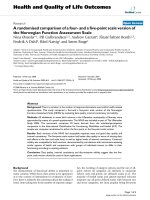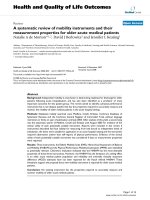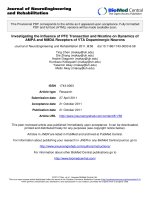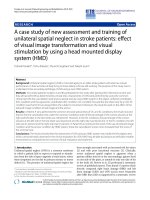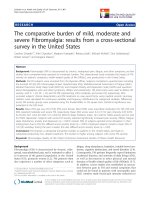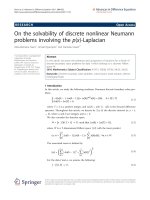Báo cáo hóa học: " Ultra-fast Microwave Synthesis of ZnO Nanowires and their Dynamic Response Toward Hydrogen Gas" docx
Bạn đang xem bản rút gọn của tài liệu. Xem và tải ngay bản đầy đủ của tài liệu tại đây (428.95 KB, 7 trang )
NANO PERSPECTIVES
Ultra-fast Microwave Synthesis of ZnO Nanowires and their
Dynamic Response Toward Hydrogen Gas
Ahsanulhaq Qurashi Æ N. Tabet Æ M. Faiz Æ
Toshinari Yamzaki
Received: 12 February 2009 / Accepted: 6 April 2009 / Published online: 25 April 2009
Ó to the authors 2009
Abstract Ultra-fast and large-quantity (grams) synthesis
of one-dimensional ZnO nanowires has been carried out by
a novel microwave-assisted method. High purity Zinc (Zn)
metal was used as source material and placed on micro-
wave absorber. The evaporation/oxidation process occurs
under exposure to microwave in less than 100 s. Field
effect scanning electron microscopy analysis reveals the
formation of high aspect-ratio and high density ZnO
nanowires with diameter ranging from 70 to 80 nm.
Comprehensive structural analysis showed that these ZnO
nanowires are single crystal in nature with excellent crystal
quality. The gas sensor made of these ZnO nanowires
exhibited excellent sensitivity, fast response, and good
reproducibility. Furthermore, the method can be extended
for the synthesis of other oxide nanowires that will be the
building block of future nanoscale devices.
Keywords ZnO Á Microwave synthesis Á Nanowires Á
FESEM Á TEM Á XPES Á H
2
gas sensor
Introduction
Fabrication of nanowires has received remarkable attention
as these one dimensional (1D) nanostructures provide an
ideal system to investigate the dependence of transport
properties on size confinement [1]. Nanowires/nanorods
are also expected to play an important role as active
components or interconnects in fabricating nanoscale
electronics and optoelectronics [2–6]. Zinc oxide (ZnO), a
wide band-gap (3.37 eV) semiconductor, is a potentially
important material. The naturally high surface-to-volume
ratio of quasi 1D ZnO nanowires has made it a contender
for chemical and biological sensors. In order to explore
these applications, availability in large quantities is nec-
essary. In this regard, various synthesis methods have been
explored to fabricate ZnO nanowires, most of which are
based on physical and chemical techniques; such as
chemical vapor transport and condensation processes,
metal-organic chemical vapor deposition, anodic alumina
membrane templates, aqueous solution process, nonhy-
drolytic sol–gel processes, pulsed laser deposition, etc.
[7–13]. All these methods mentioned above, however, have
the disadvantages of low productivity or severe impurities
from their employed assistant, so called catalyst or pre-
cursor, which bring about discomfort for their real nan-
odevice applications. Another limitation is the high
production cost due to the complex equipment, long pro-
cessing time and low growth rate. There is still an under-
lying question of how to scale-up nanoscale production
using these approaches. In this regard, microwave heating
is relatively new technique for large-scale nanowire pro-
cessing which is different from existing conventional
process.
Hydrogen is a hopeful potential fuel for cars, buses, and
other vehicles and can be transformed into electricity in
fuel cells. It is also used in medicine and space exploration
as well as in the production of industrial chemicals and
food products. Safety is an important issue when using the
hydrogen. An explosive mixture can form if hydrogen
leaks into the air from a tank or valve, posing a hazard to
A. Qurashi (&) Á T. Yamzaki
Department of Engineering, Toyama University, 3190 Gofuku,
Toyama 930-8555, Japan
e-mail:
N. Tabet Á M. Faiz
Surface Science Laboratory, Department of Physics, and Center
of Research Excellence in Nanotechnology, King Fahd
University of Petroleum and Minerals, Dhahran, Saudi Arabia
123
Nanoscale Res Lett (2009) 4:948–954
DOI 10.1007/s11671-009-9317-7
drivers, equipment operators, or others nearby. The present
technology to detect hydrogen has numerous drawbacks
which include limited dynamic range, poor reproducibility
and reversibility, high power consumption and slow
response, etc. Therefore, there is a need to develop new
generation of metal oxide-based hydrogen gas sensors with
improved performance.
In this work, we present the hydrogen gas sensing
properties of ZnO nanowires prepared by a novel one-step
ultra-fast microwave assisted method. The results show
that the ZnO nanowire gas sensor has reversible response
to H
2
gas. The work demonstrates the possibility of
developing ZnO-based low-power consumption gas sensors
and extending their applications.
Experimental Details
Zinc oxide nanostructures were synthesized using micro-
wave technique. A microwave susceptor was used in a
modified domestic microwave oven (2.45 GHz, 1250 W)
to rapidly evaporate Zn. The microwave susceptor was
prepared by mixing silicon carbide powder with oxide
additives. A small hole of 10 mm diameter and 3 mm
depth was made at the center of its top face. Small pieces of
metallic zinc flakes (2–3 mm in size) were placed in the
hole. A glass container was placed at a few centimeters
above the absorber to collect the ZnO powder. The tem-
perature of the absorber during exposure to microwaves
was monitored with a two-wavelength pyrometer (METI-
MQ11) connected to a computer. The set-up is shown in
Fig. 1. The temperature increases rapidly and exceeds
1,650 °C in less than 100 s exposures. Massive evaporation
of zinc occurs as the temperature reaches about 1,200 °C
giving rise to the formation of a vapor made of ZnO
nanostructure that deposit on the inner surface of the glass
container placed above the absorber. The crystalline phase
and morphological and structural features of the products
were investigated by X-ray diffraction (XRD Shimadzu-
6000) using Cu K
a
(0.15418 nm) radiation, field effect
scanning electron microscopy (FESEM JSM-6700F), and
high-resolution transmission electron microscopy (TEM
TOPCON EM-002B). XPS spectra were recorded by using
an Electron Spectrometer (type VG-ESCALAB MKII)
equipped with a dual (Mg/Al) X-ray source and an ion gun
(type EXO5). We have used the aluminum anode (K
a
,
1486.6 eV). Zn 2p, C 1s, and O 1s lines were recorded. The
interdigitated Pt electrode was prepared on oxidized silicon
substrate. The Pt thin film was sputtered on oxidized silicon
substrate. The sputtered Pt thin film was then patterned by
photolithography and dry etching. About 30 mg of ZnO
nanowires dispersed in ethanol and ultrasonicated. The
suspension (nanowires and ethanol) dropped onto the
interdigitated Pt electrode (3–5 lm thickness). Hydrogen
gas sensing measurements were carried out in a quartz tube
furnace. Dry synthetic air was used as a reference gas. The
gas flow was monitored by mass-flow controllers. A
computerized Agilent 34970A multimeter was used for
electrical measurements. The resistance of the samples was
determined by measuring the electric current under 10 V
potential differences between the two electrodes.
Results and Discussion
Structural Characterization
Large quantities (grams) of ZnO nanopowder were col-
lected from the inner wall of the glass container (Fig. 1).
Photographic images of the microwave absorber after
exposing for 10 and 25 s to microwave are shown in
Fig. 2a, b. Figure 2c shows the large quantity of ZnO
nanopowder obtained from a single reaction. Typical FE-
SEM images of the as-synthesized ZnO nanowires are
displayed in Fig. 3 at different magnifications. It can be
observed that the nanowires are grown in high-density and
large-scale with few micrometer length and diameter in the
range of 70–80 nm.
X-ray diffraction measurements were carried out to
examine the crystal structure of these nanowires. Figure 4
shows a typical XRD pattern that was indexed to wurtite
hexagonal structure with lattice parameters a = 3.247 A
˚
and c = 5.203 A
˚
which is consistent with reported data
(JCPDS, 79-0206). The average grain size (diameter) was
estimated to be about 70 nm using Sherrer’s formula.
Thermal shield
Microwave
susceptor
Pyrometer
Computer
Glass cup
Hole for temperature sensing
Microwave oven
Fig. 1 Schematic diagram of microwave-oven based reaction system
used for the synthesis of ZnO nanowires
Nanoscale Res Lett (2009) 4:948–954 949
123
Figure 5a illustrates the morphology of a nanowire of
70 nm diameter as revealed by TEM image. The surface of
the nanowires is generally smooth and free from structural
dislocations as shown in Fig 5b. The selected area electron
diffraction (SAED) pattern in Fig. 5c shows that the ZnO
nanowires are single crystalline in nature and grow along
the [0001] direction. A high resolution TEM (HRTEM)
image in Fig. 5d of the corresponding nanorwire is show-
ing the distance of 0.52 nm between two lattice fringes,
which represents the (0001) plane of the wurtzite hexago-
nal ZnO. The XRD and FESEM results are in agreement
with the TEM analysis.
Figure 6 shows Zn 2p
3/2
and O 1s lines of XPS spectra
of ZnO nanowires. Charge shift was corrected by fixing the
Zn 2p
3/2
line at 1021.8 eV [14]. The O 1s spectrum shows
mainly a peak at 530.4 eV with a small shoulder at about
532.0 eV. The peak is assigned to oxygen atoms bound to
Zn in ZnO while the shoulder has been assigned by many
authors to the presence of moisture as its binding energy
lies between 531.5 eV (OH
-
) and 533 eV (H
2
O) [14–16].
Growth Mechanism for the Formation of ZnO
Nanowires
Zinc oxide nanowires were grown with the uniform
diameter by ultrafast microwave synthesis technique. For
the formation of ZnO nanowires Zn metallic particles was
used as a source material. Two important factors are
responsible for the growth of ZnO nanowires: the forma-
tion of crystalline nuclei and axial growth of ZnO nuclei
[17]. The formation of nuclei depends on experimental
parameters. We used swift microwave synthesis to grow
Fig. 2 Photographic images
taken after 10 s a and b 25 s of
exposure to microwave; and c
ZnO nanopowder in grams
quantity
Fig. 3 a–d Low and high
magnification FESEM images
of ZnO nanowires
950 Nanoscale Res Lett (2009) 4:948–954
123
1D ZnO nanowires. The Zn particles were easily oxidized
into ZnO when temperature surpasses to 419 °C. Owing to
the fast oxidation, nanosized crystal nuclei were generated.
These crystal nuclei were possibly generating sites for ZnO
vapors, and thus the nanowires were most likely grown
under the control of ZnO crystal growth habit. With the
increase of reaction time and temperature, substantial
quantity of ZnO nanowires was formed. ZnO is a polar
crystal, where zinc and oxygen atoms are arranged
alternatively along the c-axis and the top surface is
Zn-terminated [0001] while the bottom surface is oxygen-
terminated ½000
"
1 [18–21]. The top surfaces are Zn-termi-
nated (0001) which are catalytically active, while the
bottom surfaces are oxygen-terminated (000ı¯) which are
chemically inert. Consequently, ZnO crystal grows fast
along the direction in which the tetrahedron corners point
[18]. The growth along the [0001] direction is dominated
over other growth facets. This implies that the c-axis is the
Fig. 5 a and b Low and high
magnification TEM images of
ZnO nanowires, c
Corresponding SAED pattern,
and d HRTEM
Fig. 4 X-ray diffraction spectrum of ZnO nanowires
Nanoscale Res Lett (2009) 4:948–954 951
123
highest growth direction and the ZnO [0001] has the
highest energy of the low-index surface which results in the
formation of 1D ZnO nanowires.
Gas Sensing Performance of ZnO Nanowires
Zinc oxide nanowires synthesized by microwave-assisted
process possess a large surface-to-volume ratio and high
crystal quality. This makes them attractive candidates for
gas and chemical sensing applications. Figure 7a illustrates
a schematic diagram of the gas sensor device. Figure 7b
shows a photograph of the device ready for measurement.
Figure 8a shows the resistance response of the ZnO
nanowires at 200 °C, as the ambient gas was changed from
synthetic air to 500 (0.1%), 1000, and 1500 ppm hydrogen
gas. The resistance decreases drastically upon exposure to
hydrogen gas, and further decreases by increasing con-
centration of H
2
from 500 to 1,500 ppm. The resistance
recovers its initial value after H
2
elimination, indicating an
excellent reproducibility of these ZnO-based gas sensors.
The response time for 500 ppm H
2
gas was about 65 s.
However, the recovery time was longer (about 148 s).
These results are consistent with the expectation of higher
relative response based on large surface-to-volume ratio
and higher crystal quality of ZnO nanowires. The gas
sensing mechanism is based on reversible chemisorption/
desorption of hydrogen on the surface of ZnO nanowires.
Oxygen is adsorbed on the surface of ZnO nanowire as O
-
or O
-2
by capturing electrons [22, 23]. The presence of a
negative charge on the surface leads to the formation of a
depletion region underneath the surface and energy band
bending due to the built-in electrical field directed toward
the surface. The width of the depletion region is expected
to change as the surface charge changes [24–27]. The
reduction of the depletion region width as a result of
desorption of negative species from ZnO surface was
suggested to explain the increase of the excitonic emission
of ZnO thin films under UV-illumination [28]. The change
of ZnO resistance under exposure to hydrogen gas is still
the subject of debate [29]. There are two different pro-
cesses that could explain the reduction of the resistance of
ZnO nanowires when exposed to hydrogen and its recovery
after switching back to the initial conditions. First, the
Fig. 6 XPS survey spectrum of ZnO nanowires: a Zn 2p
3/2
and b O
1s lines
Fig. 7 a Schematic illustration
of the ZnO nanowire gas sensor
device. The gap between two Pt
fingers is 0.04 mm; b
photograph of the ZnO
nanowire gas sensor. Gas sensor
was connected to the
measurement circuit using gold
wires
952 Nanoscale Res Lett (2009) 4:948–954
123
atomic hydrogen reacts with the negative oxygen species
leading to its desorption and the formation of water mol-
ecule. As a result, the negative charge on the surface is
reduced and so is the width of the depletion region, the
energy band bending, and the corresponding energy barrier.
Consequently, the conduction of the regions of the nano-
wires near the surface increases drastically. The process is
very fast as it is controlled by desorption of the oxygen
species. When the surface charge is completely removed,
further change of the conductivity could occur as a result of
the increase of the density of native defects such as the
ionized oxygen vacancies which evolve toward the value
corresponding to the thermodynamic equilibrium. Hydro-
gen gas is expected to react with oxygen atoms of ZnO to
form water molecules, oxygen vacancies and free electrons
in the conduction band. This process can be described by
using Kroger and Vink notations as follows:
O
x
O
þ H
2
gðÞ!H
2
OgðÞþV
€
O
þ 2e
À
where, V
€
O
represents an oxygen vacancy positively ionized
twice and O
x
O
is an oxygen atom on an oxygen site of ZnO
lattice. The above reaction shows that the presence of
hydrogen in the atmosphere leads to the increase of oxygen
vacancies that act as donors by increasing the density of
free electrons and the conductivity of ZnO nanowires. Our
results indicate that ZnO nanowires showed a slow
recovery as compared to the fast response to hydrogen
exposure. This observation suggests that the adsorption of
ionized oxygen species on the surface of ZnO nanowires
and the re-establishment of a depletion region is slower
than the process of desorption. When the H
2
flow was
discontinuous, oxygen molecules again adsorbed onto the
ZnO surface and current decreased to the initial value. The
decrease of current or recovery is controlled by diffusion
and desorption of hydrogen on the surface of nanowires.
Thus, the slow recovery is attributed to the desorption
process of hydrogen from the nanowire surface and Pt
metal surface. Finally, the sensor approached toward the
equilibrium state. Figure 8b illustrates the sensitivity of
ZnO nanowires at various operating temperatures. The
sensitivity increases by increasing the operating tempera-
ture. At the operating temperature of 250 °C, the response
of nanowires was more prominent than that of the operat-
ing temperature 150 ° C and 200 °C which can be ascribed
to the intensified reaction between the hydrogen and the
adsorbed oxygen in the increasing temperature. Further
exploration on the electrical properties of ZnO nanowires
and their doping effect on the gas sensor response are
underway.
Conclusion
In conclusion, single crystal ZnO nanowires were synthe-
sized from high purity Zn metal via an ultra-fast, micro-
wave-assisted process. The major advantage of this
technique is its simplicity, low power consumption, fast
growth (100 s), and large quantity (in grams) of nanowires.
The ZnO nanowires have a wurtzite structure and showed a
fast response and high sensitivity to hydrogen gas at
200 ° C.
Acknowledgment The authors would like to thank KFUPM for its
support. Ahsanulhaq Qurashi is thankful to venture business labora-
tory of Toyama University for post doctoral fellowship.
References
1. J. Hu, T.W. Odom, C. Leiber, Acc. Chem. Res. 32, 435 (1999).
doi:10.1021/ar9700365
2. Q. Ahsanulhaq, J.H. Kim, Y.B. Hahn, Nanotechnology 18,
485307 (2007). doi:10.1088/0957-4484/18/48/485307
3. N.K. Reddy, Q. Ahsanulhaq, J.H. Kim, Y.B. Hahn, Nanotech-
nology 18, 445710 (2007). doi:10.1088/0957-4484/18/44/445710
4. N.K. Reddy, Q. Ahsanulhaq, J.H. Kim, Y.B. Hahn, Appl. Phys.
Lett. 92, 043127 (2008). doi:10.1063/1.2839579
Fig 8 a Response of a gas sensor made of ZnO nanowires at 200 °C
to H
2
gas at different concentrations. b temperature verses sensitivity
of ZnO nanowires
Nanoscale Res Lett (2009) 4:948–954 953
123
5. N.K. Reddy, Q. Ahsanulhaq, J.H. Kim, Y.B. Hahn, Europhys.
Lett. 81, 38001 (2008). doi:10.1209/0295-5075/81/38001
6. N.K. Reddy, Q. Ahsanulhaq, Y.B. Hahn, Appl. Phys. Lett. 93,
083124 (2008). doi:10.1063/1.2975829
7. S.C. Lyu, Y. Zhang, J.C. Lee, H. Ruh, J.H. Lee, Chem. Mater. 15,
3294 (2003). doi:10.1021/cm020465j
8. W.I. Park, D.H. Kim, S.W. Jung, G.C. Yi, Appl. Phys. Lett. 80,
4232 (2003). doi:10.1063/1.1482800
9. G.S. Wu, T. Xie, X.Y. Yuan, Y. Li, L. Yang, Y.H. Xia,
D.L. Zhang, Solid State Commun. 134, 485 (2005). doi:10.1016/
j.ssc.2005.02.015
10. F.D. Zhang, D.L. Sun, L.J. Yin, C.H. Yan, M.R. Wang, J. Phys.
Chem. B 109, 8786 (2005). doi:10.1021/jp050631l
11. J.M. Zheng, D.L. Zhang, H.G. Li, Z.W. Shen, Chem. Phys. Lett.
363, 123 (2002). doi:10.1016/S0009-2614(02)01106-5
12. J.H. Choi, H. Tabata, T. Kawai, J. Cryst. Growth 226, 493 (2001).
doi:10.1016/S0022-0248(01)01388-4
13. Q. Ahsanulhaq, A. Umar, Y.B. Hahn, Nanotechnology 18,
115603 (2007). doi:10.1088/0957-4484/18/11/115603
14. J. Moulder, W.F. Stickle, P.E. Sobol, D.K. Bomben, in Handbook
of X-ray Electron Spectroscopy, ed. by J. Chastain (Perkin-Elmer,
Minnesota, 1992)
15. E. Avalle, E. Santos, A. Leiva, V. Macagno, Thin Solid Films
219, 7 (1992). doi:10.1016/0040-6090(92)90717-P
16. J.L. Meng, P.C. Moreira de Sa, P.M. dos Santos, Appl. Surf. Sci.
78, 57 (1994). doi:10.1016/0169-4332(94)90031-0
17. C. Yan, J. Liu, F. Liu, J. Wu, K. Gao, D. Xue, Nanoscale Res.
Lett. 3, 473 (2008). doi:10.1007/s11671-008-9193-6
18. C. Yan, D. Xue, J. Phys. Chem. B 110, 25850 (2006). doi:
10.1021/jp0659296
19. C. Yan, D. Xue, Electrochem. Commun. 9, 1247 (2007)
20. Q. Ahsanulhaq, S.H. Kim, J.H. Kim, Y.B. Hahn, Mater. Res.
Bull. 43, 3483 (2008). doi:10.1016/j.materresbull.2008.01.021
21. Q. Ahsanulhaq, J.H. Kim, N.K. Reddy, Y.B. Hahn, J. Ind. Eng.
Chem. 14, 578 (2008). doi:10.1016/j.jiec.2008.09.001
22. T.H. Wang, S.B. Kang, F. Ren, C.L. Tien, W.P. Sadik, P.D.
Norton, S.J. Pearton, J. Lin, Appl. Phys. Lett. 86, 243503 (2005).
doi:10.1063/1.1949707
23. F.J. Chang, H.H. Kuo, C.I. Leu, H.M. Hon, Sens. Actuators B 84,
258 (1994). doi:10.1016/S0925-4005(02)00034-5
24. R.A. Raju, C.N.R. Rao, Sens. Actuators B 4, 305 (1991). doi:
10.1016/0925-4005(91)80021-B
25. S. Saito, M. Miyayama, K. Kuomoto, H. Yanagida, J. Am.
Ceram. Soc. 68, 40 (1985). doi:10.1111/j.1151-2916.1985.tb15
248.x
26. L.H. Hartnagel, L.A. Dawar, K.A. Jain, C. Jagadish, Semicon-
ducting Transparent Thin Films (IOP, Bristol, 1995)
27. O. Lupan, G. Chui, L. Chow, Microelectron. J. 38, 1211 (2007).
doi:10.1016/j.mejo.2007.09.004
28. C. Jin, A. Tiwari, J.J.R. Narayan, Appl. Phys. (Berl) 98, 083707
(2005)
29. T.H. Wang, S.B. Kang, F. Ren, C.L. Tien, W.P. Sadik,
P.D. Norton, S.J. Pearton, J. Lin, Appl. Phys. Lett. 86, 243503
(2005). doi:10.1063/1.1949707
954 Nanoscale Res Lett (2009) 4:948–954
123


